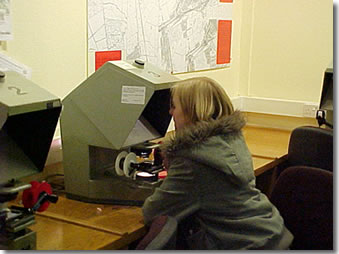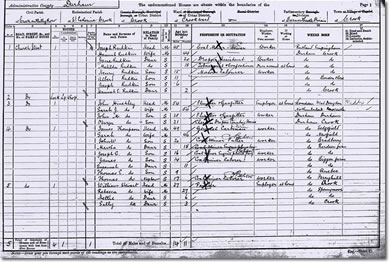Using the CensusWhat is it?
The Census is basically a headcount of everyone living in the country on a particular night. The first census in England and Wales was taken in 1801 and there has been one every 10 years since (apart from in 1941 when British involvement in the Second World War prevented it taking place). Between 1801 and 1831 only general information was collected but from 1841 details about each person were recorded. This makes the Census a wonderful source of information for historians. What can it tell us?
Each time the Census is taken, slightly different questions are asked. This is because the government needs to find out information to help it plan and provide better services. However, the following information can be gleaned from all post-1851 censuses: - name of every person resident in a particular house or other institution on Census night
- address
- age
- relation to head of household
- occupation
- place of birth
 A student from Fyndoune Community Collge using census material. (Image courtesy of Durham County Record Office.) The Census returns for Crook
We have extracted some information from the Census returns of 1851 and 1901 for Crook, which will help you discover how and why Crook and Willington developed in the latter half of the nineteenth century. Take a look at the sources and see what you can find out.  Examples of pages taken from the 1851 Census. The information relates to an area of Crook. (Image courtesy of The National Archives, ref. HO 107/2386.) Where can I see it?
The information collected on the Census is obviously personal in nature and, as a result, the returns themselves can only be seen 100 years after the Census was taken. This means that only material from the Censuses between 1841 and 1901 is currently available. The national set of census returns for England, Wales and the Channel Islands are held at the Family Records Centre in Islington, London. However, the returns for the Censuses between 1871 and 1901 can also be seen online via the National Archives website (this is a charged service). Many local record offices and libraries hold copies of the Census returns for their own area, which have often been indexed by local history and family history societies. The Census returns for County Durham are held by Durham County Record Office. What does the 1851 Census tell us? Example extract from the 1851 Census showing data relating to Crook. (Image courtesy of The National Archives, ref. HO 107/2386 f222). Click on image to enlarge. Take a close look at the information extracted from the 1851 Census using the Transcript. Then try to answer the questions below.Alternative questions for use with a Key Stage 3 Class can be found here. 1. Using the information in the 1851 Census extract, draw and label a bar graph showing the top 5 birthplaces of the population in Crook. For people born in England just name the county. 2. After Co. Durham, where did the majority of Crook’s settlers originate. Can you explain this? 3. How many of the people in this sample were born in Crook? How many of these were adults? 4. What does this tell us about how Crook was developing at this period of time? 5. What are the gender, age and occupation of the majority of lodgers in Crook in 1851? 6. What two things can we learn from this piece of information? 7. What does looking at the occupations of the majority of inhabitants of Crook in 1851 tell you about the types of work available in the area? Once you have finished and you are happy with your answers, try looking at the 1901 Census to see what changes. What does the 1901 census tell us? Example extract from the 1901 Census showing data relating to Crook. (Image courtesy of The National Archives, RG 13/4653, f5.) Click on image to enlarge. Take a close look at the information extracted from the 1901 Census using the Transcript. Then try to answer the questions below. 1. Using the information contained in the extract from the 1901 census, draw and label a bar graph showing the top 5 birthplaces of the population of Crook in 1901. For people born in England just name the county. 2. How many of the people in this sample were born in Crook and how many of these were adults? 3. Compare this with your findings for 1851. What does this tell us about how Crook has developed over a period of 50 years? 4. Look in the column marked ‘Rank, Profession or Occupation’ on the 1901 census. Make a list of the jobs that people are doing in 1901. 5. How has this answer changed in comparison to your findings for 1851? 6. Can you give any reasons why this is the case? Are there any links between the different occupations? 7. Why do you think there are still a lot of lodgers in Crook in 1901? 8. Now that you have used the two census extracts make a comment on the usefulness of the sources for population study? Are you happy with your answers? If so, move on to the next section – using maps. |
|
| 



